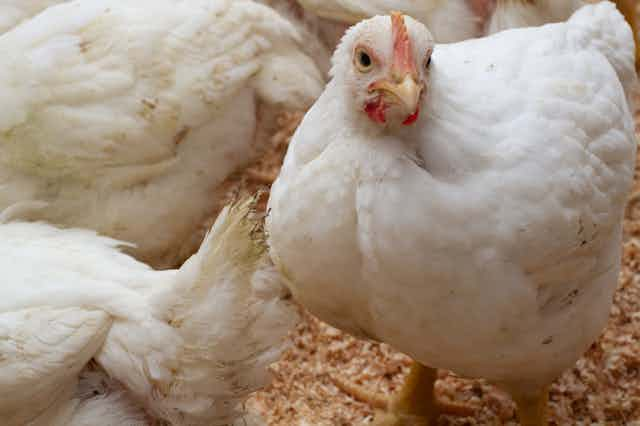The chicken sheds I conduct research in are enormous – over three-quarters the length of a football field and 20 metres wide. In each house, around 28,000 near-identical broiler chickens, which are the type we use for meat, are reared in six-week production cycles.
My research helps farms find ways to improve the welfare of these birds. This might involve adjusting their lighting, improving the design of perches or seeing how different breeds compare. With so many animals per house, it makes sense to consider how any change affects the flock as a whole.
Thinking about broilers as a group also makes sense because they are considered to be a pretty homogeneous bunch. One effect of selectively breeding these animals to maximise how much meat they produce is that they all reach slaughter weight at the same time and all look very similar. So, short of dispatching a student with very good eyesight to follow a single chicken around for weeks, monitoring an individual broiler under commercial conditions is impossible.
Researchers get around this by either monitoring 100 birds and assuming they represent the 28,000 or keeping 100 broilers in a pen, applying a change to them and hoping it is similar enough to commercial conditions to get valid results.

But what if we want to know how individual broilers experience their environment? My colleagues and I in the Animal Welfare Unit at Queen’s University Belfast turned to developments in indoor tracking technology for help. Along with Icelandic software company Locatify, we have been working to adapt a commercial system that can show where individual chickens are in the house in real-time. By attaching backpacks to chickens, we discovered just how different each bird is – and it could help us learn to meet their needs better.
Chicken backpacks
The ultra-wideband tags we used to monitor the movements of the chickens are usually found tracking forklifts in warehouses or attached to lanyards to track people as they move around offices or museums.
Ultra-wideband is a radio technology that works by recording how long it takes for a signal to move from the transmitter (or tag) to a receiver. This data can be used to identify the object’s position to within 30cm.
Crucially, the tags were small enough that they could be placed inside specially designed backpacks for chickens to carry over several weeks. The system recorded their location and movement during this time, giving a clear view of how they used the house.

When I explained this concept to one of the farmers, he waved an arm towards one corner of the house and told me he was certain he saw the same chicken in that corner every morning. Another farmer was convinced they roamed around as they pleased, using the whole house.
It turns out they were both right.
We were surprised to find that, despite how homogeneous the chickens and their environments are, there were still significant differences between their movement patterns. We followed 17 chickens in our first trial with the new tracking system and, while one spent the majority of its time within 10 metres of the area I originally tagged it in, another visited over 97% of the house across a week.

We got another chance to see whether chickens really preferred one bit of the house to another when we penned and then released the tagged birds after the initial observation week. We wanted to see whether the chickens would return to the area we had collected them from, and a few did. Three out of nine chickens collected from the back of the house made their way back there within 24 hours. But five never returned to those original spots for the rest of the production cycle.
Variety is the spice of life
So why was there so much variation? There are a few obvious influences on broiler movement that we looked at first. Using one of the two methods outlined above, many studies have found that heavier birds, older birds and those with leg issues are significantly less active. We struggled to match any of these issues conclusively with our tagged broilers.
The two heaviest broilers did roam around the house the least, but a number of lighter birds used less space than heavier ones. Our one lame tagged broiler was recorded in 69% of the house, while a lighter broiler with a better gait occupied 43%. We did see less activity as birds aged, but even this was not predictable and depended on the individual.
We couldn’t even nail down a link between space use and activity, meaning that broilers exploring less of the house were moving around in their area as much as broilers using a larger amount of space.
Although all of this didn’t produce the neat graphs I was hoping for, it did suggest that perhaps broilers aren’t as homogeneous as we thought.
Like most animals, it makes sense that chicken behaviour is influenced by each individual’s personality traits. Perhaps broilers that are bolder are more likely to explore the house in detail. Are more fearful chickens more likely to be startled by farm staff or other birds and so keep moving around? Do some chickens have better spatial awareness than others? Are some more likely to form social bonds than others?
We hope to continue using this tracking technology to delve deeper into why particular broilers use space the way they do – and what changes can be made to create the best possible environment for the group and for the individual.

